|
|
|
Sort Order |
|
|
|
Items / Page
|
|
|
|
|
|
|
| Srl | Item |
| 1 |
ID:
158777
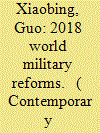

|
|
|
| 2 |
ID:
082243


|
|
|
|
|
| Publication |
2008.
|
| Summary/Abstract |
The debates on the pace, scope and nature of Ottoman military reform tend to be dominated by domestic and/or cultural explanations. Issues of military competition and efficiency, embodied in Neorealist perspectives, might appear to have little to offer as an explanatory tool in the Ottoman context. This article argues that this view is mistaken. First, despite their value, there remains an indeterminacy about domestic and cultural explanations that limits their usefulness as single-cause explanations. Second, Neorealism does generate valuable insights into the dynamics of military reform in the Ottoman Empire; issues of military competition and efficiency do matter in explaining the nature of Ottoman military reform during this period. Ultimately, domestic, cultural, and Neorealist perspectives are complementary, and mono-causal explanations of eighteenth century developments in the Ottoman military are likely to be too simplistic
|
|
|
|
|
|
|
|
|
|
|
|
|
|
|
|
| 3 |
ID:
118484
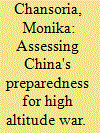

|
|
|
| 4 |
ID:
124524
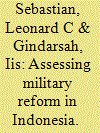

|
|
|
|
|
| Publication |
2013.
|
| Summary/Abstract |
This article seeks to assess the magnitude of military reform in Indonesia and its impact in establishing greater levels of professionalism within the armed forces. To this end, the authors will offer some reflections on the studies of civil-military relations and military transformation for inculcating a higher degree of military professionalism; analyse to what extent the process of military reform in Indonesia has reshaped the institutional role of the armed forces; and discern three major strategic gaps in Indonesia's military reform, namely the "legal loopholes and regulation vacuum," the "shortcomings of democratic civilian control," and the "defence-economic gap." This article asserts that military professionalism will grow more substantially depending on the ability of civilian elites to exercise effective control over the military and the capacity of the government to transform the military establishment keeping pace with strategic challenges and operational requirements.
|
|
|
|
|
|
|
|
|
|
|
|
|
|
|
|
| 5 |
ID:
114839
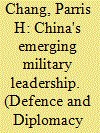

|
|
|
| 6 |
ID:
052831
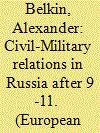

|
|
|
|
|
| Publication |
Autumn-Winter 2003.
|
|
|
|
|
|
|
|
|
|
|
|
|
|
|
|
| 7 |
ID:
085122
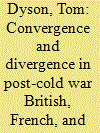

|
|
|
|
|
| Publication |
2008.
|
| Summary/Abstract |
Post-Cold War military reforms in Britain, France, and Germany have been characterized by patterns of convergence in the objectives, instruments, and institutional forums of defense policy but by divergence in temporality. These patterns of convergence and divergence cannot be fully explained by cultural approaches. Neither can they be explained solely by a focus on the role of international structure, as neo-realism posits, although the post-Cold War distribution of capabilities is driving Britain, France, and Germany toward policy convergence. Instead, the analysis builds upon the insights of neoclassical realism. Culture emerges not so much as a cause of action as instrumental and a resource for policy leaders in the domestic political and temporal management of reform.
|
|
|
|
|
|
|
|
|
|
|
|
|
|
|
|
| 8 |
ID:
182633
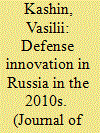

|
|
|
|
|
| Summary/Abstract |
The chapter examines the driving forces and the institutions behind the Russian military buildup in the period between 2010 and 2020. The beginning of the rapid Russian military modernization in late 2000s was the result of the shifting threat assesments by the Russian political leadership and the painful lessons of the war with Georgia in 2008. Russia had to conduct an throughout and painful restructuring of the military institutions and the defense industrial complex in order to be able to meet the ambitious goals of its’ rearmament program. The result was significant growth in the Russian military capabilities by the middle of the decade.
|
|
|
|
|
|
|
|
|
|
|
|
|
|
|
|
| 9 |
ID:
090977


|
|
|
|
|
| Publication |
2009.
|
| Summary/Abstract |
The attempt of the Georgian government to reform and restructure its military forces in the past ten years demonstrates the difficulty of conducting Western-style defense reform in postconflict states, which have not seen a formal end to armed conflict. Western-style reforms were intended to bring Georgia greater peace, stability, and accountability, with the added benefit of training additional soldiers to support regional peacekeeping operations. Domestic political imperatives within Georgia, however, demanded that the government restore the territorial integrity of the state by "reintegrating" South Ossetia, Abkhazia, and Adjara. In this context, additional organizational and doctrinal interoperability of Georgian forces was desirable, but only to the extent that it enabled Georgian forces to meet these primary domestic political requirements. For Georgia, a country with a weak military tradition and unresolved domestic conflicts causing political controversy at home, military reform was not just an abstract step toward democracy but a potential means to an end of resolving those same conflicts by force or threat of force.
|
|
|
|
|
|
|
|
|
|
|
|
|
|
|
|
| 10 |
ID:
084039


|
|
|
|
|
| Publication |
2008.
|
| Summary/Abstract |
Recent scholarship on communal violence in Indonesia since the late New Order has focused on identifying causal mechanisms of particular subtypes of communal violence such as large-scale communal violence, town-level communal rioting, intervillage violence, and lynching. While such analyses are useful in understanding aspects specific to each subtype of violence, analyzing each subtype separately risks the analytical problem of selection on the dependent variable if there are important similarities across subtypes. Drawing on the observation that each of these subtypes appeared to rise and fall together since the late New Order, I propose a common factor that can explain the broad temporal patterns of communal violence. In particular, I point to increasing restraints on the military that arose from intraregime infighting, greater scrutiny of military actions during the keterbukaan (political openness) period, and the withdrawal of the military from police duties during Reformasi. I examine four cases of communal conflict: (1) a case in which intravillage violence was averted, (2) a case of lynching, (3) a case of lynching and subsequent intervillage reprisals, and (4) a case of large-scale communal violence. The first three cases are from Lampung province, and the fourth is the case of Poso district, Central Sulawesi.
|
|
|
|
|
|
|
|
|
|
|
|
|
|
|
|
| 11 |
ID:
121815
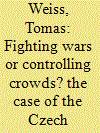

|
|
|
|
|
| Publication |
2013.
|
| Summary/Abstract |
The article explores the reform of the Czech military from the perspective of the possible blurring of police and military functions. The understanding of security has changed in recent years and the European militaries have taken up nontraditional tasks both within and outside Europe. Moreover, the fiscal conditions have provoked further reconsideration of the role of military. The Czech Republic's armed forces have undergone a number of reforms since 1989. The article focuses on three factors distinguishing the military from the police: territorial scope, use of force, and responsibility before the law. It concludes that although the Czech military has become more flexible, it does not use all its potential in practice, especially domestically. The article suggests that despite the adaptation to the new security environment, the military continues to be distinct from police.
|
|
|
|
|
|
|
|
|
|
|
|
|
|
|
|
| 12 |
ID:
151257
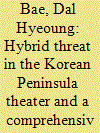

|
|
|
|
|
| Summary/Abstract |
This paper seeks to redefine the concept and status of hybrid warfare through a comprehensive analysis and discussion of various aspects of future warfare. Also the definition of the construct of the hybrid threat and an analysis of the applicability of hybrid warfare in the Korean Peninsula Theater (KPT) is provided in this paper. In addition, on the premise of hybrid threats in the KPT, this paper sets the overall direction of the capability and methods of strategic concept development and concept realization. It suggests a possible direction of improvements for establishing effective and practical, united means for the Republic of Korea (ROK) Armed Forces. In this respect, this paper aims to contribute to creating and proliferating general consensus on balanced, evolutionary development for the inception and employment of appropriate strategy against possible hybrid threats it the KPT. It is also expected that this will assist in establishing or improving the government policy in connection with hybrid threats and in promoting consistency in works related to hybrid threats by setting an appropriate direction for such policies.
|
|
|
|
|
|
|
|
|
|
|
|
|
|
|
|
| 13 |
ID:
123928
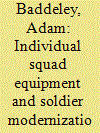

|
|
|
|
|
| Publication |
2013.
|
| Summary/Abstract |
The article discusses the soldier modernisation efforts of Southeast Asian nations which pose several challenges for both designers and buyers. Indonesia's efforts are focused on the needs of the Minimum Essential Force (MEF) to improve its overall capabilities in conflict areas and border regions. Malaysia's Soldier Advanced Kombat Technology Integrated (SAKTI) programme is led by the Army. The Philippines has purchased military supplies including combat net radios.
|
|
|
|
|
|
|
|
|
|
|
|
|
|
|
|
| 14 |
ID:
178641
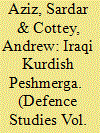

|
|
|
|
|
| Summary/Abstract |
During the war against Islamic State from 2014 to 2017 the Iraqi Kurdish Peshmerga became important local allies of the United States and its international partners, playing a significant role in the eventual defeat of Islamic State. In 2017, backed by the US and its Western allies, the Kurdistan Regional Government (KRG) agreed plans to reform and modernize the Peshmerga. This article provides an analysis of this reform process. Reform is severely constrained by two problems. First, the continuing soft civil war between Iraqi Kurdistan’s two main political parties, the Kurdish Democratic Party (KDP) and the Patriotic Union of Kurdistan (PUK), within which both parties view their maintenance of independent Peshmerga forces as central to their power and political survival. Second, the heroic-mythic status of the Peshmerga within Iraqi Kurdish society, which makes it difficult to convert the Peshmerga into a “normal” military force. Reform efforts to date have not addressed these issues. Until such time as the deep political divide between the KDP and the PUK is addressed, Peshmerga reform is unlikely to make significant progress – the military cart cannot be put before the political horse.
|
|
|
|
|
|
|
|
|
|
|
|
|
|
|
|
| 15 |
ID:
059199


|
|
|
|
|
| Publication |
Oct-Dec 2004.
|
|
|
|
|
|
|
|
|
|
|
|
|
|
|
|
| 16 |
ID:
150742
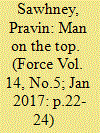

|
|
|
| 17 |
ID:
054231
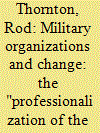

|
|
|
|
|
| Publication |
Jul-Sep 2004.
|
|
|
|
|
|
|
|
|
|
|
|
|
|
|
|
| 18 |
ID:
151590


|
|
|
|
|
| Summary/Abstract |
THE MILITARY REFORM announced by the top leadership of the Communist Party of China (CPC) and the Chinese cabinet in 2015 is a large-scale and in-depth enterprise. It aims to impart a new quality to the People's Liberation Army (PLA) and other armed services.
|
|
|
|
|
|
|
|
|
|
|
|
|
|
|
|
| 19 |
ID:
079009
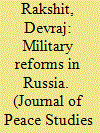

|
|
|
| 20 |
ID:
130034
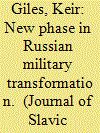

|
|
|
|
|
| Publication |
2014.
|
| Summary/Abstract |
Fundamental reform of Russia's military has passed through a number of distinct phases since its inception in late 2008. This paper describes the phase of consolidation and stability begun in early 2011. Based on research to June 2012, and pre-dating the replacement of Anatoliy Serdyukov as Russian Defence Minister, the paper shows how early planning and forecasting deficiencies were addressed from 2011 onward, with continuing support at the highest level for the overall aims of military reform. Ongoing problems such as procurement and manpower are discussed as serious challenges to Russian military aspirations, and further specific challenges affecting each individual arm of service are described. In conclusion, Russia's new military capabilities, and the state's rationale for introducing them, are considered.
|
|
|
|
|
|
|
|
|
|
|
|
|
|
|
|
|
|
|
|
|